VT Dendro Lab Notes
American elderberry
Caprifoliaceae
Sambucus nigra ssp. canadensis
Leaf: Opposite, pinnately compound, 6 to 11 inches long, with 5 to 11 elliptical, serrate leaflets, acuminate tips, bottom leaflets are often 3-lobed, dark green above and much paler below.
Flower: Species is monoecious; small, white, borne in dense, flat-topped clusters, up to 8 inches across, appearing in summer.
Fruit: Small, berrylike drupe, purple-black, and very juicy, up to 1/4 inch in diameter, borne in flat-topped clusters, maturing in late summer.
Twig: Stout, silvery- to yellow-gray with obvious, warty lenticles, large white pith; buds are very small, red-brown and pointed, terminal buds are generally lacking.
Bark: Smooth and brown with obvious warts, becoming shallowly furrowed and rough with age.
Form: A large shrub or small tree often with multiple stems that are spreading or arching reaching up to 12 feet tall. The trunk is usually short.
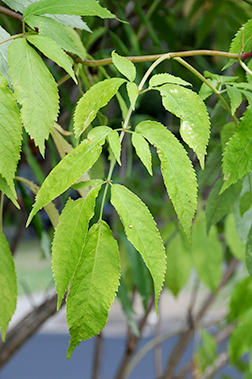


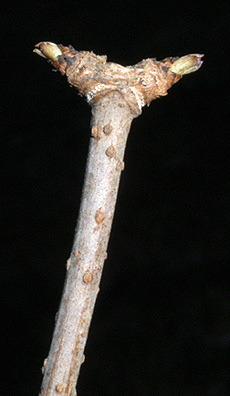
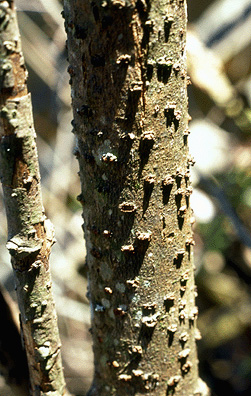
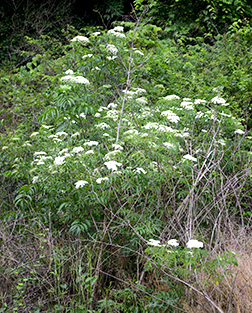

Notes:
VT Dendro Lab Notes
mapleleaf viburnum
Caprifoliaceae
Viburnum acerifolium
Leaf: Opposite, simple, suborbicular in shape, 3 to 4 inches long, 3-lobed, coarsely dentate, palmately veined with veins sunken on upper surface giving the leaf a slightly wrinkled look, pubescent below and on the petiole, green above and paler below.
Flower: Species is monoecious; very small, white, appearing in flat topped clusters 1 1/2 to 3 inches across appearing in early summer.
Fruit: Drupes, 1/4 inch in diameter, rounded, red turning purple to black when ripe, occur in flat topped clusters; maturing in fall.
Twig: Slender, velvety-gray; buds ovoid, stalked with 4 dark purple scales.
Bark: Smooth, grayish brown.
Form: An upright suckering shrub that often grows in dense clumps and reaches up to 5 feet tall.


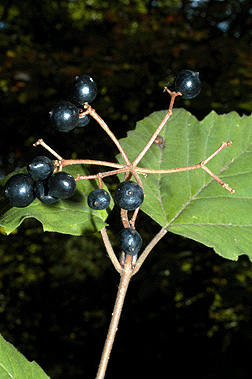




Notes:
VT Dendro Lab Notes
autumn-olive
Elaeagnaceae
Elaeagnus umbellata
Leaf: Alternate, simple, 1 to 3 inches long, 1 to 1 1/2 inches wide, lanceolate in shape with an entire margin. Leaves are green and distinctly scaly above, silvery and scaly below.
Flower: Bell-shaped, 1/2 inch long, very fragrant, lacking petals, yellow-white, appearing in spring.
Fruit: Berry-like achene, red covered with silver scales, 1/4 to 1/3 inch long, sweet and juicy, matures in late summer.
Twig: Young branches are silvery and scaly, and may bear thorns, later developing a light brown color; buds are small, silvery-brown and rounded, covered with 4 scales.
Bark: Smooth and gray when young, becoming split and furrowed later.
Form: A shrub or very small tree to 15 feet, rounded in outline.







Notes:
VT Dendro Lab Notes
trailing arbutus
Ericaceae
Epigaea repens
Leaf: Alternate, evergreen, ovate to nearly oval, hairy margins, 2 to 3 inches long, heart-shaped base and somewhat thickened, shiny dark green above, a bit lighter and hairy beneath.
Flower: Perfect, white, pink to nearly red, 5 petals, up to 1/2 inch across, groups of 3 to 5, very fragrant, appearing in early to mid-spring.
Fruit: Berry-like, round capsule, 1/2 inch across, pale yellow-orange, ripens in late summer.
Twig: Basically not present, nearly prostrate stems are reddish brown, hairy and slightly shreddy; buds with loose green scales.
Bark:
Form: Low growing, creeping woody herb, large leaves are mostly all that is visible.







Notes:
VT Dendro Lab Notes
teaberry
Ericaceae
Gaultheria procumbens
Leaf: Alternate, simple, evergreen, oval to elliptical, 1 to 2 inches long, minutely serrated, thickened with a wintergreen odor when crushed, leaves appear whorled since they cluster at tips of plant; dark shiny green above, much paler below often with black dots.
Flower: Species is monoecious; small (1/4 inch), white, urn-shaped, hanging from short stems from leaf axils, appearing in mid to late summer.
Fruit: Red, round, 1/4 to 1/2 inch in diameter, hanging beneath the leaves, mild wintergreen taste, ripen in late summer and persist into winter.
Twig: Slender, green turning brown with age.
Bark: Light brown.
Form: Low plant with a height of only 3 to 5 inches; stems shoot out of the ground and end in a tight cluster of leaves.







Notes:
VT Dendro Lab Notes
partridgeberry
Rubiaceae
Mitchella repens
Leaf: Opposite, evergreen, oval to heart-shaped leaf, 1/2 inch across, parallel veined, dark green above with a paler yellow-green midrib, pale yellow below.
Flower: Species is monoecious; tubular, 1/2 inch long, 4 white to faint pink fuzzy petals, appearing in mid-summer.
Fruit: Bright red berry, oval, 1/4 to 3/8 inches across, edible and persist through the winter.
Twig: Very delicate and barely woody, light green to brown in color.
Bark:
Form: A creeping, delicate vine, does not climb and is often covered by fallen leaves.







Notes:
VT Dendro Lab Notes
common greenbrier
Smilacaceae
Smilax rotundifolia
Leaf: Alternate, simple, rounded to cordate, 2 to 5 inches long, parallel veined, entire margins, shiny green above, paler below.
Flower: Species is monoecious; small light yellow-green, borne in small round clusters in late spring.
Fruit: Dark blue to black berries, borne in clusters, often covered with a powdery, waxy bloom; maturing in late summer and persist over winter.
Twig: Stout, green, usually sharply 4-angled with many scattered, stiff prickles, climbs with tendrils; very tough and stiff but new spring sprouts are tender and edible.
Bark: Remaining green for a long period of time, turning brown on old stems.
Form: Most often a climbing vine, but may also form a small, tangled bush.







Notes:
VT Dendro Lab Notes
Virginia creeper
Vitaceae
Parthenocissus quinquefolia
Leaf: Alternate, palmately compound, 4 to 8 inches across, with five elliptical leaflets per leaf, with coarsely crenate to serrate margins, shiny green above and paler below.
Flower: Small, not showy, green and borne in clusters on long stems, appear in summer.
Fruit: A blue-black berry, 1/4 inch in diameter, borne in long-stemmed clusters, maturing in late summer.
Twig: New stems are slender, light brown in color, with numerous reddish lenticels, tendrils are apparent opposite the buds, ending in adhesive pads; buds are broadly conical with orange-brown scales; leaf scars are nearly round and concave.
Bark: Gray-brown, becoming coarsely hairy due to aerial roots and tendrils. When rapidly growing, the aerial roots are bright, orange-brown.
Form: A climbing vine that may provide ground cover or ascend to fifty feet. Stems may get several inches in diameter.







Notes:























































